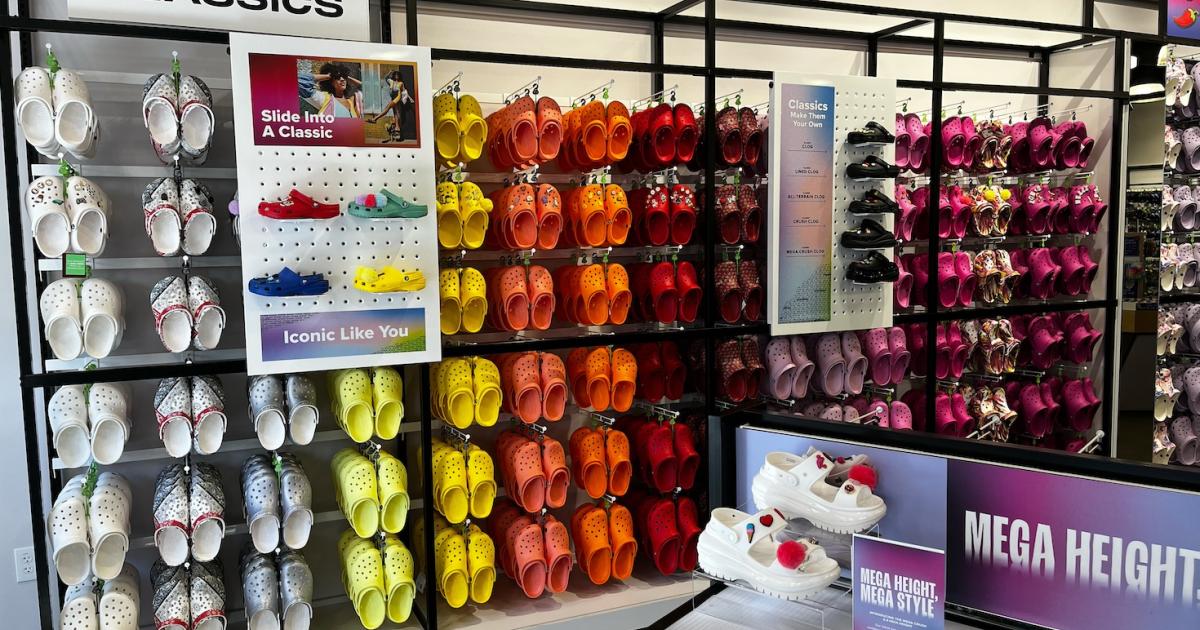
Crocs launched a program in October to take back used shoes in 10 U.S. states, to keep old footwear out of landfills and explore new ways to reuse the material.
It’s a big opportunity. An estimated 22 billion pairs of shoes are thrown out annually while roughly the same number are produced, according to industry stats. The fashion and apparel sector contributes about 8 percent of greenhouse gas emissions each year, according to the United Nations.
Crocs announced a series of sustainability goals in 2021, but quietly delayed its plan to reach net zero by a decade to 2040 after the company reported a big increase in emissions between 2021 and 2022. Deanna Bratter, vice president and global head of sustainability for the Broomfield, Colorado-based company, said circular design and production principles are core to delivering on that commitment.
“When you think about the circular economy, sometimes people just think about waste and doing something with waste,” Bratter said. “But when we think about the concept of creating a circular economy, it requires a variety of solutions, a lot of creativity.”
Three things will help Crocs deliver, she said:
- Design changes that enable products to be used for longer.
- Considering the need for future deconstruction and recyclability.
- Finding sources for renewable inputs.
From ‘gently used’ to ‘unwearable’
Crocs’ new collection program will produce metrics to help it better understand the social and operational challenges it faces, Bratter said.
Rather than randomly assigning takeback locations on a nationwide basis, it picked states that represent a cross-section of attitudes about climate change: Colorado, Georgia, Illinois, Michigan, Massachusetts, Minnesota, Ohio, Pennsylvania, Virginia and Wisconsin. Retail locations in those states, about 50 in total, will include collection bins to make it simpler for consumers to drop off products.
Crocs will accept shoes in any condition. “Gently used” ones will be donated to Soles4Souls, a nonprofit that works with entrepreneurs building secondhand apparel businesses. Those that are “well-loved” or “unwearable” will head back to Crocs, where product designers will experiment with ways to reuse the materials, Bratter said.
Here are some questions Crocs hopes to answer with its collection program:
- Who is returning shoes?
- What marketing messages are working?
- Are consumers donating because of the social or environmental impact?
- What types of shoes are most commonly returned and how old are they?
- Do gently used or well-loved shoes dominate the bins?
The goal is to expand nationally, Bratter said. Crocs chose the U.S. as its first foray into product take-back because it can transport them to other locations for processing more easily.
What’s inside Crocs’ clogs
The predominant material in Crocs’ clogs — more than 81 percent — is Croslite, a proprietary resin designed for durability and sourced predominantly from fossil fuels. Croslite is responsible for 35-40 percent of Crocs’ emissions, its largest single source, Bratter said.
Crocs has committed to sourcing 50 percent of its Croslite from bio-based options by 2030. The two most prominent alternative sources are tall oil, a byproduct from paper mills, and used cooking oil. In 2022, only 2.2 percent of Croslite came from non-fossil sources, but Crocs is on track to meet 20 percent by the end of 2023, Bratter said.
Crocs is also increasing its use of recycled material. The company uses manufacturing scraps in 6.5 percent of its Croslite, according to the company’s 2022 ESG report. It’s possible that unwearable shoes collected by Crocs could be ground down and used in future products, increasing that amount, Bratter said, but it hasn’t publicly set goals for how many of them will be converted.
Baby steps rather than a big leap
The entire footwear sector is under pressure to cut waste and reduce emissions, according to Paul Foulkes-Arellano, founder of Circuthon Consulting and co-author of a book about materials and sustainability. While he praised Crocs’ decision to partner with “well-respected” Soles4Souls, he characterized the footwear company’s overall circular economy strategy as nascent and said it’s “notoriously difficult” to make takeback programs work at scale.
One advantage Crocs will have as it transitions is the makeup of Croslite. “It’s principally a monomaterial, so once the few extra components are removed, it can be reground as material for new shoes,” he said. Recycling a material that includes both fossil fuels- and plant-based resins is more difficult, he said.
Other shoemakers are striving for higher percentages of reused material on a shorter timeline, Foulkes-Arellano said. “The footwear industry is way behind the textiles industry in its understanding of environmental impacts.”
- SEO Powered Content & PR Distribution. Get Amplified Today.
- PlatoData.Network Vertical Generative Ai. Empower Yourself. Access Here.
- PlatoAiStream. Web3 Intelligence. Knowledge Amplified. Access Here.
- PlatoESG. Carbon, CleanTech, Energy, Environment, Solar, Waste Management. Access Here.
- PlatoHealth. Biotech and Clinical Trials Intelligence. Access Here.
- Source: https://www.greenbiz.com/article/crocs-taking-its-used-shoes-back-10-states-heres-why
- :has
- :is
- :where
- 10
- 20
- 2021
- 2022
- 2023
- 2030
- 22
- 50
- 7
- 8
- a
- About
- Accept
- According
- ADvantage
- After
- also
- alternative
- amount
- an
- and
- announced
- Annually
- answer
- any
- apparel
- ARE
- AS
- At
- back
- basis
- BE
- because
- behind
- Better
- between
- Big
- Billion
- bins
- book
- both
- Building
- businesses
- but
- by
- came
- CAN
- challenges
- change
- Changes
- characterized
- chose
- circular economy
- Climate
- Climate change
- Co-Author
- collection
- Colorado
- commitment
- committed
- commonly
- company
- Company’s
- components
- concept
- condition
- consulting
- Consumers
- contributes
- converted
- cooking
- Core
- could
- Creating
- creativity
- Cut
- decade
- decision
- Delayed
- deliver
- delivering
- Design
- design and production
- designed
- designers
- difficult
- doing
- dominate
- donating
- down
- Drop
- durability
- each
- easily
- economy
- Emissions
- enable
- end
- Entire
- entrepreneurs
- environmental
- ESG
- estimated
- Ether (ETH)
- Expand
- experiment
- explore
- extra
- faces
- Fashion
- few
- First
- For
- For Consumers
- Foray
- fossil
- fossil fuels
- founder
- Free
- from
- fuels
- future
- GAS
- Georgia
- Global
- goal
- Goals
- greenhouse gas
- Greenhouse gas emissions
- Ground
- Have
- he
- head
- help
- here
- higher
- hopes
- How
- HTML
- HTTPS
- illinois
- Impact
- Impacts
- in
- include
- includes
- Increase
- increasing
- industry
- inputs
- inside
- interested
- into
- IT
- ITS
- just
- Keep
- largest
- launched
- learning
- locations
- longer
- Lot
- make
- makeup
- manufacturing
- many
- Marketing
- massachusetts
- material
- materials
- Meet
- messages
- Metrics
- Michigan
- mills
- minnesota
- more
- most
- nascent
- nationally
- Nationwide
- Need
- net
- New
- Newsletter
- node
- Nonprofit
- number
- october
- of
- off
- Ohio
- Oil
- Old
- on
- once
- ones
- only
- operational
- Opportunity
- Options
- or
- Other
- our
- out
- overall
- pairs
- Paper
- partner
- Paul
- Pennsylvania
- People
- percent
- picked
- plan
- plato
- Plato Data Intelligence
- PlatoData
- possible
- Praised
- predominantly
- president
- pressure
- principles
- PRNewswire
- processing
- produce
- Produced
- Product
- Production
- Products
- Program
- Programs
- prominent
- proprietary
- publicly
- Questions
- quietly
- rather
- reach
- recycled
- recycling
- reduce
- Removed
- Renewable
- Reported
- represent
- requires
- Resin
- responsible
- retail
- returning
- reuse
- roughly
- s
- Said
- same
- Scale
- scraps
- sector
- set
- she
- single
- So
- Social
- Solutions
- some
- something
- sometimes
- Source
- sourced
- Sources
- Sourcing
- States
- Steps
- Strategy
- striving
- Sustainability
- Take
- taking
- textiles
- than
- that
- The
- Them
- they
- things
- think
- those
- timeline
- to
- Total
- track
- transitions
- transport
- two
- types
- u.s.
- under
- understand
- understanding
- United
- use
- used
- uses
- variety
- vice
- Vice President
- virginia
- Waste
- Way..
- ways
- we
- weekly
- when
- while
- why
- will
- Wisconsin
- with
- Work
- working
- works
- Yahoo
- year
- you
- zephyrnet
- zero








